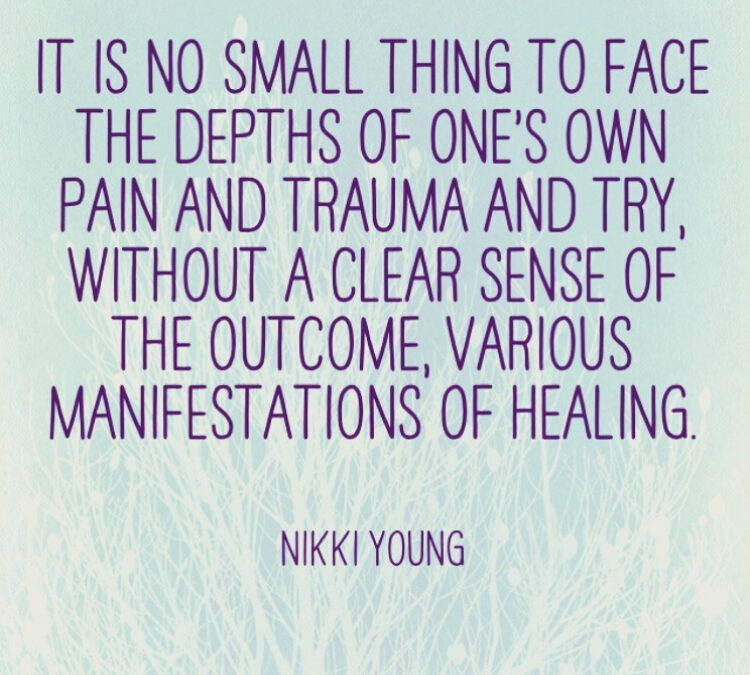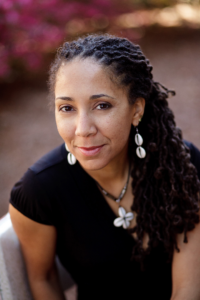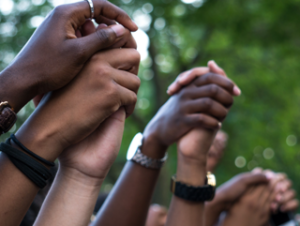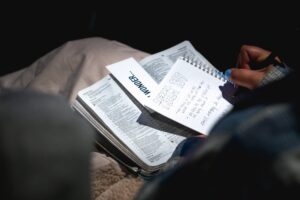Our livability—the capacity to be and stay alive while pursuing the experience of happiness and liberation—is directly related to the synchronistic, symbiotic, and balanced health of our spirits, minds, emotions, and bodies. Here, I choose to use the plural to signify the depth, necessity, and interdependence of our individual and collective livability, just as Monica Coleman does in Bipolar Faith. “Each component of my life was a connected knot, binding me to other people and practices that kept me alive,” she says (256). As individuals, we most significantly access the possibility of life when we experience such a balance; as a people, we have it when we intentionally work toward, fiercely protect, and continuously ensure the circumstances of livability for and with one another.
Through her heart-in-hand writing approach to theological reflection and process theology, Coleman takes us on a confrontation tour—one which relieves readers of the opportunity to avoid, ignore, or deny the impact of mental illness, relational brokenness, oppression, and trauma on multiple aspects of our lives. Through an agile and graceful dance of introspection, critical narration, social analysis, and spiritual reflection, Coleman invites readers to make room within ourselves to witness and attend to another’s (her) holy work of pursuing life and ongoing livability. In the writing of the text, Coleman compels us not only to think theologically but to feel theologically as well. She blurs the lines between reason and experience, mind and body in a way that allows us to fully engage what Audre Lorde calls “erotic knowledge.” In so doing, we can more fully and honestly nurture our own desire and effort to live beyond, not despite, the generational inheritance and tangible effects of individual and collective grief, depression, and trauma.
Two aspects of Coleman’s book enhance the possibility of such a nurturing for me. The first is her negotiation of relational complexity through the narration of her relationship with her Mama. In fact, one of the most striking lines in the book comes when Coleman reflects on her experience of her mother’s active love as she navigated weeks of “the Illness.”
I have a Mama who stopped her life for six weeks to save mine. . . . She knew how to take care of me. I forgot that. Because she didn’t understand my response to the rape, I forgot. But I knew then. My Mama still knew how to take care of me.” (256)
When her mother traveled to California to feed and nurture her, drive her to class and take notes, Coleman recalled the same mother who decided to save both of their lives by leaving Coleman’s father. Mama, whose response to Coleman’s decision to report the rape emerged from a concern with what people might think and say, responded differently to the illness. Coleman noticed that during the illness, her mother asked her what she needed and gave it to her without judgment or trepidation about others’ assessments of Coleman’s needs and choices. As I read, I considered Coleman’s reflection of the moment to be an important reminder that the sickness that made it so that Grandma could “no longer mother . . . [and] no longer grandmother” was altogether different from the death-dealing Illness that she and her mother barely survived (10). This illness was a bodily response to sadness, depression, fatigue, and loneliness. This illness, as Coleman describes it, was soul-deep.
The second aspect of the book that helps me reflect on our desires and efforts to live beyond grief and depression is a little more difficult for me to name. I’ll admit that it feels patronizing and paternalistic when I say it to myself. But, if Coleman’s book does anything, it calls us to honesty. So, here it is: I am proud of Coleman. I have no right to say it that way, but that’s the feeling that her book evokes. I am proud that she chose life over and over again. It is no small thing to face the depths of one’s own pain and trauma and try, without a clear sense of the outcome, various manifestations of healing. Turning the trope of “strong black woman” on its head, Coleman places herself outside of the value economy of strength and weakness. She situates herself, instead, as a persistent listener to the “still, small voice” that echoes the past, her ancestors, her family, her spiritual comrades, her education, and ultimately herself. While she did not seem to find God in the wind, the earthquake, or the fire—understandably so!—Coleman reflects the ways that she and her loved ones held onto her intention to find and be in relation with God. And, at least in my reading, that intentional refusal was enough for her to survive.
This refusal is a queer process of theological construction. It is Coleman’s refusal to maintain the positivist progression of death, found in the linear logic of trauma-pain-grief-death, which denaturalizes and destabilizes the relationship among them. Through an unapologetic interrogation of linearity and a dismissal of a (theological) narrative coherence that ought to lead to her own destruction, Coleman confronts the nature of inheritance itself. By offering her stories as she does, Coleman helps the reader draw lines between what we take in through our blood and the world around us and what we leave on the threshing floor to wither away and die. In this process, the seeming inescapability of destruction that trauma and depression produce turns into something different: the inescapability becomes the depression, trauma, and death.
When I read the first sentences, I took in a sharp breath . . . and held it. By beginning the book with the unforgiving sharpness of death, focusing on its inevitability and even its justification, Coleman appears to construct a story of resurrection after death. “You can die from grief,” she opens. “You can invest so much of what you need in others that you don’t know how to live without them. . . . I know this because my great-grandfather died of grief” (xv). Yet, after a few paragraphs, I realize that her story is actually one about what it means to benefit from the miracle of and simultaneously hold on to life. In short, hers is not a story of grief-induced death; rather it is a narration of what it means to refuse to die. This refusal seems to mean, for Coleman, developing life-saving rituals (189). It means committing minister-fraud so that you can whisper life into yourself while speaking to others (190). It means pursuing the life of the mind (248), and then healing from the isolating impact of that effort (300). It means therapy in a variety of forms, falling in love, saying goodbye to certain relationships in order to grow, while recognizing the potential of others to help or facilitate that growth. I value this meaning-making map of survival, and I honor the ways that Coleman chases livability by navigating the refusal of death.
Response to Thelathia “Nikki” Young
Writing about depression is always hard for me. I’ve written and spoken out about sexual violence since the late ’90s. But, in my case, rape was a discrete event that happened once, and had a beginning and an end—even when the aftermath and healing was processive. But depression is not over for me. It is something that I still live with. It hasn’t ended. I often asked myself: How am I supposed to write about something in the past that is not past? I was, to use Thelathia “Nikki” Young’s language, struggling with the ongoing aspect of livability—which she defines as “the capacity to be and stay alive while pursuing the experience of happiness and liberation.” How, I asked myself, did I stay alive? And how have I managed, in the midst of such despondence, a pretty good life with lots of joy and freedom in it too?
While Young does not name it this way, her response to Bipolar Faith and these unwritten questions feels like a thoroughly womanist response. Womanists often write about our/their relationships with mothers and grandmothers. Womanist theologians write of maternal relationships with both nostalgia and complex realism. And then womanists reflect on how these relationships shape faith. Delores Williams refers to her grandmother who spoke about “making a way out of no way.” Joanne Marie Terrell writes about her mother and how her bloodshed serves as a sacramental witness. Renita Weems describes her relationship with her mother vis-à-vis biblical mothers. These were among the womanist theologians I was reading during the time span of Bipolar Faith, and they too reflect the ferocity, faith, wisdom, betrayal, fear and care in which I describe my mother and grandmother. The older I get, the more I understand the kinds of choices my mother and grandmother made to stay alive; choices that render categorial imperatives moot. They made race- and gender-influenced choices so that they could survive in a sharecropping South or Jim Crow US or an urban North with and without family nearby, on too few resources and not enough patience and love. Williams sacralizes this surviving, and names it as salvific.
That my mother and grandmother fought for their educations and loved me protectively and fiercely . . . that is the marvel. Even when their choices felt like betrayal. It took therapy and maturity to situate them in the larger context of deep care and grounded faith. Not just the bearer of my life, my mother’s nurture sustained my life when living was not guaranteed. I am now fifteen years after the last year described in Bipolar Faith, and roles have shifted again. I am now a caregiver for my aging mother. I consider it an honor and a joy to offer her a quality of life with emotional depth and daily mirth. But when I wail out in tears over a grief that is fairly regular, it is her nurture that I miss. I miss the way she traversed life’s greatest transitions with me, always knowing exactly what I needed to be well. I want her to do the same thing in my current transitions. I wonder who will do that for me in the future. Yes, I learned some livability from her. I’ve learned livability for both myself, and my daughter. Yet I still crave to be mothered in that way.
Young describes a second dimension to livability as the ability to choose life over and over again. She writes, “It is no small thing to face the depths of one’s own pain and trauma and try, without a clear sense of the outcome, various manifestations of healing.” I feel like Young sees the ongoing struggle for exactly what it is. It is difficult. It is a big thing—to choose life over and over again. It is not fun. It often sucks. It can be exhausting. But it is everything. Or rather—it is the key to my own livability. Because those of us who live with depressive conditions walk far too often on an edge close to death. To have livability—more than survival, but the quality of life that Williams describes, a life with happiness and freedom—I must choose again, try again, seek God again, refuse again. And each time I do this, I do not know the outcome, and I do not know what I will lose on the way.
Young shows me two things I had not noticed. First Young sees these choices—these sightless attempts—as a meaning-making map of survival. Is that, I ask in hindsight, what I created? A way to get my own bearing when lost? A path that others can follow? A compass to find true north? A queer construction? If so, let me plot these out on paper graphically to help me in my next instance of choosing.
Young also reminds me that I fail to theologize womanist resurrection the way I should. Young aptly notes that choosing life is more than not-choosing death. Rather it is choosing life through and amid the threat of death. Choosing life means growing and changing and losing. I’ve long felt that each depressive episode is an existential death. Something big dies—my faith, something I believed about myself, something I trusted about the world, a road I once traveled. And I miss it. I miss whatever I’ve lost. I miss it with a deep aching. But I press forward because of a deep tenacious belief in life after death. Resurrection. I believe that the end is not the end. I believe that the past can fuel the present. I believe in ancestors. And I believe in the rituals of the interstices—breaking bread, making love, fostering community, telling stories, dancing drumbeats, walking barefoot in the earth. This pursuit of livability is not achieved by my own will and fortitude. Rather, as generations of faithful people have affirmed, it is divine activity.
Originally published here





Our livability—the capacity to be and stay alive while pursuing the experience of happiness and liberation—is directly related to the synchronistic, symbiotic, and balanced health of our spirits, minds, emotions, and bodies. Here, I choose to use the plural to signify the depth, necessity, and interdependence of our individual and collective livability, just as Monica Coleman does in Bipolar Faith. “Each component of my life was a connected knot, binding me to other people and practices that kept me alive,” she says (256). As individuals, we most significantly access the possibility of life when we experience such a balance; as a people, we have it when we intentionally work toward, fiercely protect, and continuously ensure the circumstances of livability for and with one another.
Through her heart-in-hand writing approach to theological reflection and process theology, Coleman takes us on a confrontation tour—one which relieves readers of the opportunity to avoid, ignore, or deny the impact of mental illness, relational brokenness, oppression, and trauma on multiple aspects of our lives. Through an agile and graceful dance of introspection, critical narration, social analysis, and spiritual reflection, Coleman invites readers to make room within ourselves to witness and attend to another’s (her) holy work of pursuing life and ongoing livability. In the writing of the text, Coleman compels us not only to think theologically but to feel theologically as well. She blurs the lines between reason and experience, mind and body in a way that allows us to fully engage what Audre Lorde calls “erotic knowledge.” In so doing, we can more fully and honestly nurture our own desire and effort to live beyond, not despite, the generational inheritance and tangible effects of individual and collective grief, depression, and trauma.
Two aspects of Coleman’s book enhance the possibility of such a nurturing for me. The first is her negotiation of relational complexity through the narration of her relationship with her Mama. In fact, one of the most striking lines in the book comes when Coleman reflects on her experience of her mother’s active love as she navigated weeks of “the Illness.”
When her mother traveled to California to feed and nurture her, drive her to class and take notes, Coleman recalled the same mother who decided to save both of their lives by leaving Coleman’s father. Mama, whose response to Coleman’s decision to report the rape emerged from a concern with what people might think and say, responded differently to the illness. Coleman noticed that during the illness, her mother asked her what she needed and gave it to her without judgment or trepidation about others’ assessments of Coleman’s needs and choices. As I read, I considered Coleman’s reflection of the moment to be an important reminder that the sickness that made it so that Grandma could “no longer mother . . . [and] no longer grandmother” was altogether different from the death-dealing Illness that she and her mother barely survived (10). This illness was a bodily response to sadness, depression, fatigue, and loneliness. This illness, as Coleman describes it, was soul-deep.
The second aspect of the book that helps me reflect on our desires and efforts to live beyond grief and depression is a little more difficult for me to name. I’ll admit that it feels patronizing and paternalistic when I say it to myself. But, if Coleman’s book does anything, it calls us to honesty. So, here it is: I am proud of Coleman. I have no right to say it that way, but that’s the feeling that her book evokes. I am proud that she chose life over and over again. It is no small thing to face the depths of one’s own pain and trauma and try, without a clear sense of the outcome, various manifestations of healing. Turning the trope of “strong black woman” on its head, Coleman places herself outside of the value economy of strength and weakness. She situates herself, instead, as a persistent listener to the “still, small voice” that echoes the past, her ancestors, her family, her spiritual comrades, her education, and ultimately herself. While she did not seem to find God in the wind, the earthquake, or the fire—understandably so!—Coleman reflects the ways that she and her loved ones held onto her intention to find and be in relation with God. And, at least in my reading, that intentional refusal was enough for her to survive.
This refusal is a queer process of theological construction. It is Coleman’s refusal to maintain the positivist progression of death, found in the linear logic of trauma-pain-grief-death, which denaturalizes and destabilizes the relationship among them. Through an unapologetic interrogation of linearity and a dismissal of a (theological) narrative coherence that ought to lead to her own destruction, Coleman confronts the nature of inheritance itself. By offering her stories as she does, Coleman helps the reader draw lines between what we take in through our blood and the world around us and what we leave on the threshing floor to wither away and die. In this process, the seeming inescapability of destruction that trauma and depression produce turns into something different: the inescapability becomes the depression, trauma, and death.
When I read the first sentences, I took in a sharp breath . . . and held it. By beginning the book with the unforgiving sharpness of death, focusing on its inevitability and even its justification, Coleman appears to construct a story of resurrection after death. “You can die from grief,” she opens. “You can invest so much of what you need in others that you don’t know how to live without them. . . . I know this because my great-grandfather died of grief” (xv). Yet, after a few paragraphs, I realize that her story is actually one about what it means to benefit from the miracle of and simultaneously hold on to life. In short, hers is not a story of grief-induced death; rather it is a narration of what it means to refuse to die. This refusal seems to mean, for Coleman, developing life-saving rituals (189). It means committing minister-fraud so that you can whisper life into yourself while speaking to others (190). It means pursuing the life of the mind (248), and then healing from the isolating impact of that effort (300). It means therapy in a variety of forms, falling in love, saying goodbye to certain relationships in order to grow, while recognizing the potential of others to help or facilitate that growth. I value this meaning-making map of survival, and I honor the ways that Coleman chases livability by navigating the refusal of death.
Response to Thelathia “Nikki” Young
Writing about depression is always hard for me. I’ve written and spoken out about sexual violence since the late ’90s. But, in my case, rape was a discrete event that happened once, and had a beginning and an end—even when the aftermath and healing was processive. But depression is not over for me. It is something that I still live with. It hasn’t ended. I often asked myself: How am I supposed to write about something in the past that is not past? I was, to use Thelathia “Nikki” Young’s language, struggling with the ongoing aspect of livability—which she defines as “the capacity to be and stay alive while pursuing the experience of happiness and liberation.” How, I asked myself, did I stay alive? And how have I managed, in the midst of such despondence, a pretty good life with lots of joy and freedom in it too?
While Young does not name it this way, her response to Bipolar Faith and these unwritten questions feels like a thoroughly womanist response. Womanists often write about our/their relationships with mothers and grandmothers. Womanist theologians write of maternal relationships with both nostalgia and complex realism. And then womanists reflect on how these relationships shape faith. Delores Williams refers to her grandmother who spoke about “making a way out of no way.”2 Joanne Marie Terrell writes about her mother and how her bloodshed serves as a sacramental witness.3 Renita Weems describes her relationship with her mother vis-à-vis biblical mothers.4 These were among the womanist theologians I was reading during the time span of Bipolar Faith, and they too reflect the ferocity, faith, wisdom, betrayal, fear and care in which I describe my mother and grandmother. The older I get, the more I understand the kinds of choices my mother and grandmother made to stay alive; choices that render categorial imperatives moot. They made race- and gender-influenced choices so that they could survive in a sharecropping South or Jim Crow US or an urban North with and without family nearby, on too few resources and not enough patience and love. Williams sacralizes this surviving, and names it as salvific.
That my mother and grandmother fought for their educations and loved me protectively and fiercely . . . that is the marvel. Even when their choices felt like betrayal. It took therapy and maturity to situate them in the larger context of deep care and grounded faith. Not just the bearer of my life, my mother’s nurture sustained my life when living was not guaranteed. I am now fifteen years after the last year described in Bipolar Faith, and roles have shifted again. I am now a caregiver for my aging mother. I consider it an honor and a joy to offer her a quality of life with emotional depth and daily mirth. But when I wail out in tears over a grief that is fairly regular, it is her nurture that I miss. I miss the way she traversed life’s greatest transitions with me, always knowing exactly what I needed to be well. I want her to do the same thing in my current transitions. I wonder who will do that for me in the future. Yes, I learned some livability from her. I’ve learned livability for both myself, and my daughter. Yet I still crave to be mothered in that way.
Young describes a second dimension to livability as the ability to choose life over and over again. She writes, “It is no small thing to face the depths of one’s own pain and trauma and try, without a clear sense of the outcome, various manifestations of healing.” I feel like Young sees the ongoing struggle for exactly what it is. It is difficult. It is a big thing—to choose life over and over again. It is not fun. It often sucks. It can be exhausting. But it is everything. Or rather—it is the key to my own livability. Because those of us who live with depressive conditions walk far too often on an edge close to death. To have livability—more than survival, but the quality of life that Williams describes, a life with happiness and freedom—I must choose again, try again, seek God again, refuse again. And each time I do this, I do not know the outcome, and I do not know what I will lose on the way.
Young shows me two things I had not noticed. First Young sees these choices—these sightless attempts—as a meaning-making map of survival. Is that, I ask in hindsight, what I created? A way to get my own bearing when lost? A path that others can follow? A compass to find true north? A queer construction? If so, let me plot these out on paper graphically to help me in my next instance of choosing.
Young also reminds me that I fail to theologize womanist resurrection the way I should. Young aptly notes that choosing life is more than not-choosing death. Rather it is choosing life through and amid the threat of death. Choosing life means growing and changing and losing. I’ve long felt that each depressive episode is an existential death. Something big dies—my faith, something I believed about myself, something I trusted about the world, a road I once traveled. And I miss it. I miss whatever I’ve lost. I miss it with a deep aching. But I press forward because of a deep tenacious belief in life after death. Resurrection. I believe that the end is not the end. I believe that the past can fuel the present. I believe in ancestors. And I believe in the rituals of the interstices—breaking bread, making love, fostering community, telling stories, dancing drumbeats, walking barefoot in the earth. This pursuit of livability is not achieved by my own will and fortitude. Rather, as generations of faithful people have affirmed, it is divine activity.
Originally published here